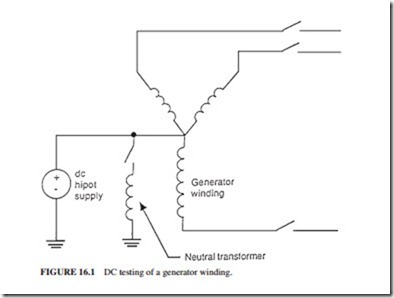Insulation Resistance and Polarization Index
The polarization index (PI) and insulation resistance tests indicate the presence of cracks, contamination, and moisture in the insulation. They are commonly performed on any motor and generator winding. They are suitable for stator and insulated rotor windings.
The insulation resistance is the ratio of the dc voltage applied between the winding and ground to the resultant current. When the dc voltage is applied, the following current com- ponents flow:
1. The charging current into the capacitance of the windings.
2. A polarization or absorption current due to the various molecular mechanisms in the insulation.
3. A “leakage” current between the conductors and ground (the creepage path). This com- ponent is highly dependent on the dryness of the windings.
The first two components of the current decay with time. The third component is mainly determined by the presence of moisture or a ground fault. However, it is relatively constant. Moisture is usually absorbed in the insulation and/or condensed on the end winding sur- faces. If the leakage current is larger than the first two current components, then the total charging current (or insulation resistance) will not vary significantly with time.
Therefore, the dryness and cleanliness of the insulation can be determined by measuring the insulation resistance after 1 min and after 10 min. The polarization index is the ratio of the 10-min reading to the 1-min reading.
Test Setup and Performance. Several suppliers, such as Biddle Instruments and Genrad, offer insulation resistance meters that can determine the insulation resistance accurately by providing test voltages of 500 to 5000 V dc. For motors and generators rated 4 kV and higher, 1000 V is usually used for testing the windings of a rotor, and 5000 V is used for testing the stator windings.
To perform the test on a stator winding, the phase leads and the neutral lead (if accessible) must be isolated. The water must be drained from any water-cooled winding, and any hoses removed or dried thoroughly by establishing a vacuum (it is preferable to remove the hoses because vacuum drying is usually impossible).
The test instrument is connected between the neutral lead or one of the phase leads and the machine frame (Fig. 16.1). To test a rotor winding, the instrument should be connected between a lead from a rotor winding and the rotor steel. During the test, the test leads should be clean and dry.
Interpretation. If there is a fault or the insulation is punctured, the resistance of the insu- lation will approach zero. The IEEE standard recommends a resistance in excess of (VL-L 1) MD. If the winding is 13.8 kV, the minimum acceptable insulation resistance is 15 MD. This value must be considered the absolute minimum since modern machine insulation is on the order of 100 to 1000 MD. If the air around the machine had high humidity, the insulation resistance would be on the order of 10 MD.
The insulation resistance depends highly on the temperature and humidity of the winding. To monitor the changes of insulation resistance over time, it is essential to perform the test under the same humidity and temperature conditions. The insulation resistance can be corrected for changes in winding temperature. If the corrected values of the insulation resistance are decreasing over time, then there is deterioration in the insulation.
However, it is more likely that the changes in insulation resistance are caused by changes in humidity. If the windings were moist and dirty, the leakage component of the current (which is relatively constant) will predominate over the time-varying components. Hence, the total current will reach a steady value rapidly. Therefore, the polarization index is a direct measure of the dryness and cleanliness of the insulation. The PI is high (>2) for a clean and dry winding. However, it approaches unity for a wet and dirty winding.
The insulation resistance test is a very popular diagnostics test due to its simplicity and low cost. It should be done to confirm that the winding is not wet and dirty enough to cause a failure that could have been averted by a cleaning and drying out procedure.
The resistance testing has a pass/fail criterion. It cannot be relied upon to predict the insulation condition, except when there is a fault in the insulation.
The high potential tests, whether dc or ac, are destructive testing. They are not generally recommended as maintenance-type tests. For stator windings rated 5 kV or higher, a partial discharge (PD) test, which in the past has been referred to as corona, should be done. The level of partial discharge should be determined because it can erode the insulation and lead to insulation aging.
